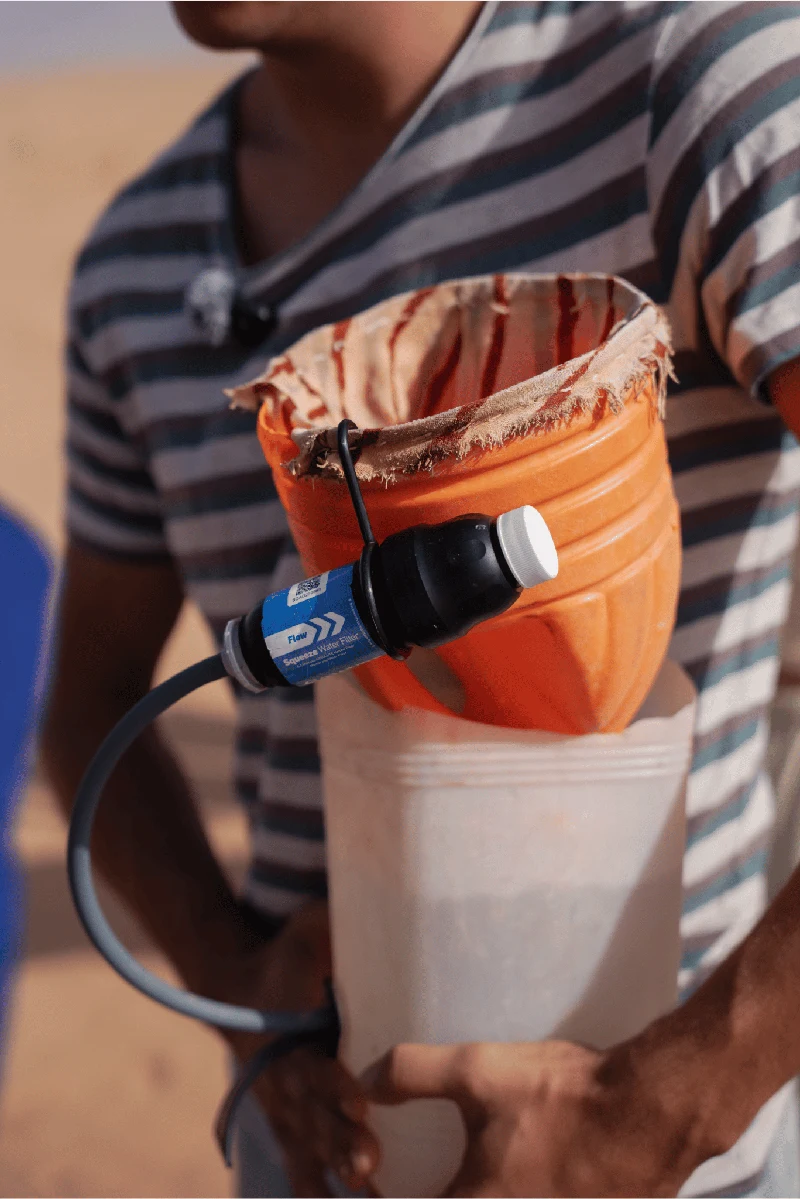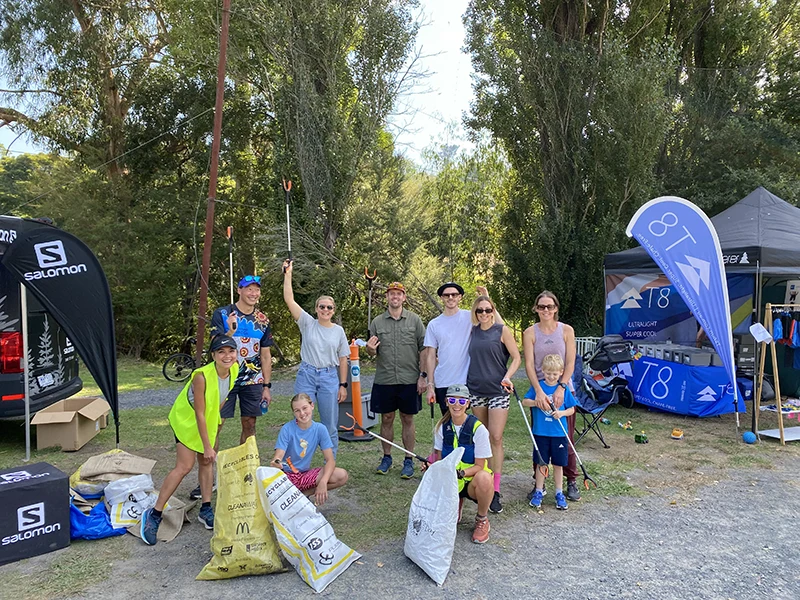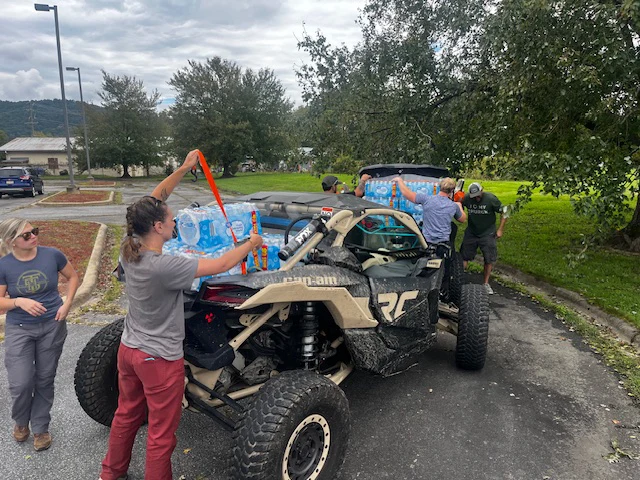

“There's burnt trees that come down without warning, rockslides from burned root systems, temperatures that bring on heat exhaustion and dehydration, steep hills, vertical cliffs, hornets, snakes, bears, cougars, poison oak, bulldozers, chainsaws, constant smoke inhalation, and of course...the fire itself. Keeping your head on a swivel daily is not a habit to learn, it's a necessity.”
War on Wildland Fires: From the Frontline
Matt Wentzell, Sawyer partner and team member of REMs, shares his personal experience of fighting some of the largest fires of the 2021 season.

Former guide, park ranger and now full-time adventure enthusiast, Matt currently works on a technical rescue team for wildland firefighters throughout the US. The team is known as REMS, or Rapid Extraction Module Support, and provides advanced life support, vehicle extrication and high or low angle technical rope rescue.
The reason why these teams exist on wildfires is due to the extremely hazardous environments firefighters encounter when working throughout America's varying landscapes. From the deep canyons and deserts of the Southwest, to the steep and high Rocky Mountains, to the old growth forests of the Pacific Northwest, the need for support has been increasing as fires rip across the states with growing frequency and intensity. Although we have many tools such as aircraft and heavy machinery to aid in fighting these fires, crews still need to hike in, sometimes for miles, to access the fires edge. Thus, it was imperative to establish a safe and efficient way to get injured persons out to more advanced care.

This need was typically fulfilled by federal agencies and local structure fire departments, however the demand has outgrown the supply, so private contract companies have come out in full. The company I work for falls into this category. Based out of Bend, OR Adventure Medics has been growing rapidly with a full staff of medical teams for outdoor events around the state, single resource paramedics and EMTs for wildland fire, and the REMS teams. When not on fire rescue and support, my team trains 40 hours per week on rope rescue skills, vehicle extrications, medical scenarios, and a daily routine of physical training. Once we get the call for a fire, we have a 4-hour response time and we pack up and head out.
Typically, a day in the life of wildland fire starts with getting out of your sleeping bag… Rarely are there the same luxuries most are used to having back home. Almost all crews are tent camping in a park, field, or wherever the incident command post was established to organize resources. Sometimes they're even spiked out deep in the forest where the fire needs most attention. There's usually a chow line for breakfast, some supplies like paper bag lunches and water, and a morning briefing about the day's efforts and where crews will be placed. Then it's off to the races.
And a race it is indeed. A wild arena to work in, you need to know your weather, relative humidity, wind direction, terrain, and the types of fuels (trees, plants, etc) that may affect fire behavior that day. You must know your escape routes and safety zones in case the fire overwhelms the work or dramatically changes. There's burnt trees that come down without warning, rockslides from burned root systems, temperatures that bring on heat exhaustion and dehydration, steep hills, vertical cliffs, hornets, snakes, bears, cougars, poison oak, bulldozers, chainsaws, constant smoke inhalation, and of course...the fire itself. Keeping your head on a swivel daily is not a habit to learn, it's a necessity.

Usually, crews work 14 days straight with the option of extending to 21, then law states a mandatory two days off. Typically, it's a 16-hour work day, but that can vary depending on resource needs, and boy are there are many, many resources to organize. From communications to planning, to finance, food, logistics, operations, medical, and even mobile shower units, everyone has a role to play and many hours to work. As a rescue team, we're typically sent in with the crews in the more hazardous areas of operations due to the likelihood of injury. Constantly ready with medical support or rescue while the crews work digging line, laying hose, chopping trees, or protecting homes, it’s an odd type of low-key stress waiting for the radio to squawk, “REMS team report for a medical emergency” and the brain begins to formulate just what type of scenario we are about to encounter. It’s either that, or the radio says nothing at all but normal fire operation communication. “Keeping you guys bored makes us happy” is the typical response we get from supervision, and we couldn’t agree more. If we get called, something has gone terribly wrong, but we remain vigilant and trained for such a cThe types of crews you’ll see fighting fire range from Type 1 to Type 6. This relates to the level of capabilities of the resource. A Type 1 fire engine, for instance, you’re used to seeing around town from your local fire department. Whereas a Type 6 engine may only be a pickup truck with a water tank on the back. Hand crews come in batches upwards of 10 or 20 persons and they hike into seriously gnarly terrain carrying hoses, tools, water, food, and work tirelessly all day long, day after day. There are water tenders, heavy equipment, helicopters, and the typical hierarchy you’ll see for most natural disasters around the states. As the simple nature of fire is dynamic, thus is the work. A constantly changing environment, there is definitely no shortage of excitement throughout your time spent there.

The elephant in the room begins to appear, however, when you sit back and start looking at wildfire statistics over the past several decades. Climate change is affecting the planet worldwide and I have seen it from so many different places. Guiding glaciers in Alaska and New Zealand, we constantly had to change our trips because the glaciers were rapidly melting away. Around the globe on climbing expeditions, my partners and I have to consider different routes due to new rockfall hazards or decreasing snowpacks. And now, working these fires in the states during yet another record season, it's really beginning to show its ugly head. Preceding that, unfortunately….are people.
Around 85% of wildfires in America are started by humans. Whether it's campfires, cigarettes out the window, or fireworks, people are beginning to realize just how dry our forests are becoming, and the consequences of a misplaced spark.
So besides following our very important Leave No Trace principles, here's some more tips I've learned for those wanting to help bring that percentage down and save some forests, homes, and the lives of those helping to put out the flames.
Vehicles:
- Proper maintenance of your vehicle (ex. leaking oil or other fluids, dirty exhaust, old oil, etc) helps to reduce accidental sparks.
- Always carry a shovel, fire extinguisher, or extra water in your vehicle.
- Don't park over dry grass or brush due to exhaust heat possibly setting it ablaze.
- Always look under your vehicle after you’ve parked and before you drive away when in areas susceptible to fire.
Van life is an amazing life and I encourage all to partake! I’ve been living in vans for almost 8 years now, but we must be mindful of the impact it has and remember it's a giant metal can full of flammable fluids.
Camping:
- Be aware of and follow campfire regulations or bans in your area.
- Monitor local weather and droughts or forest fires that may be nearby. Many times, roads, campgrounds, or entire forests are closed to assist the fire crews in safely moving equipment and personnel on the ground while also protecting you from the hazards.
- Some good sites are inciweb.nwcg.gov and fsapps.nwcg.gov for fire locations and public information in the US.
- Educate yourself about relative humidity, wind directions, and how to read weather patterns. (Bonus points if you learn about fire behavior!)
- Use backpacking stoves when possible and follow all regulations regarding stoves or campfires for local forests. Take care when using fuels and canisters.
- If having a campfire, make it small enough for needs and make it in designated campfire rings if available. Always have firefighting materials nearby when possible, (water, fire extinguisher, shovel, bucket, etc). Otherwise make a ring with rocks and clear brush away from the campfire and only use proper wood. Certain materials like cardboard, paper, and pine needles can throw embers into the already very dry surrounding trees. Don't burn trash!!!
- Always have plenty of water or lots of dirt to put fire out. Remember, fire needs a heat source, oxygen, and fuel to maintain itself. When extinguishing, stir the ashes with ample amounts of water to guarantee it is saturated and snuffed out completely. Coals can stay hot for days and one gust of wind can throw them into the forest long after you've left. If required to dispose of coals in a bin, take care and use a proper bin.
As a former park ranger, I don’t have enough fingers and toes to count how many times I had to put out fires after campers had left or ask patrons to not build a fire fifteen feet tall. Please be mindful of the impact we all play into this ever-growing issue.
Miscellaneous:
- Take great care in using fireworks. Firework accidents start many forest fires.
- If you're a smoker, please don't throw your cigarettes out your car window (or just try quitting😉)
- If you see smoke or fire, report it to the local fire department or nearest park authorities as soon as you can. You may give them enough time to stop it before it takes off.
- If you own a home or live in an area that is susceptible to fire, try cleaning up the yard of debris or leaves, trimming lower limbs off trees, and keeping flammable materials away from the house. It may just be enough to keep the structure standing if a fire rolls through. Help thy neighbor!
- Most importantly, continue to teach yourself and others what you learn so we can combat an issue that is reversible.
As a final note, please consider giving your local wildland firefighters a wave and a smile when and if you see them! Reach out and let them know you understand what they sacrifice for this type of work. Sometimes the human connection is enough to provide the push one needs to endure the long days and nights spent away from friends and family. Kindness and generosity goes a long way in this world and that cup can never be full enough!!
Much love to everyone out there, and keep adventuring!
Matt Wentzell
From the Squad
Campfire conversations with our community, from Squad Members and Ambassadors to Brand Partners and the Sawyer team.

















